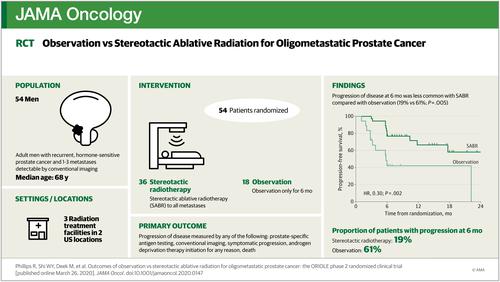当前位置:
X-MOL 学术
›
JAMA Oncol.
›
论文详情
Our official English website, www.x-mol.net, welcomes your
feedback! (Note: you will need to create a separate account there.)
Outcomes of Observation vs Stereotactic Ablative Radiation for Oligometastatic Prostate Cancer: The ORIOLE Phase 2 Randomized Clinical Trial.
JAMA Oncology ( IF 22.5 ) Pub Date : 2020-03-26 , DOI: 10.1001/jamaoncol.2020.0147 Ryan Phillips 1 , William Yue Shi 2 , Matthew Deek 1 , Noura Radwan 1 , Su Jin Lim 3 , Emmanuel S Antonarakis 3 , Steven P Rowe 4, 5 , Ashley E Ross 5 , Michael A Gorin 4, 5 , Curtiland Deville 1 , Stephen C Greco 1 , Hailun Wang 1 , Samuel R Denmeade 3 , Channing J Paller 3 , Shirl Dipasquale 1 , Theodore L DeWeese 1, 3, 5 , Daniel Y Song 1, 3, 5 , Hao Wang 3 , Michael A Carducci 3 , Kenneth J Pienta 3, 5 , Martin G Pomper 4, 5 , Adam P Dicker 6 , Mario A Eisenberger 3 , Ash A Alizadeh 7 , Maximilian Diehn 2 , Phuoc T Tran 1, 3, 5
JAMA Oncology ( IF 22.5 ) Pub Date : 2020-03-26 , DOI: 10.1001/jamaoncol.2020.0147 Ryan Phillips 1 , William Yue Shi 2 , Matthew Deek 1 , Noura Radwan 1 , Su Jin Lim 3 , Emmanuel S Antonarakis 3 , Steven P Rowe 4, 5 , Ashley E Ross 5 , Michael A Gorin 4, 5 , Curtiland Deville 1 , Stephen C Greco 1 , Hailun Wang 1 , Samuel R Denmeade 3 , Channing J Paller 3 , Shirl Dipasquale 1 , Theodore L DeWeese 1, 3, 5 , Daniel Y Song 1, 3, 5 , Hao Wang 3 , Michael A Carducci 3 , Kenneth J Pienta 3, 5 , Martin G Pomper 4, 5 , Adam P Dicker 6 , Mario A Eisenberger 3 , Ash A Alizadeh 7 , Maximilian Diehn 2 , Phuoc T Tran 1, 3, 5
Affiliation

|
Importance
Complete metastatic ablation of oligometastatic prostate cancer may provide an alternative to early initiation of androgen deprivation therapy (ADT).
Objective
To determine if stereotactic ablative radiotherapy (SABR) improves oncologic outcomes in men with oligometastatic prostate cancer.
Design, Setting, and Participants
The Observation vs Stereotactic Ablative Radiation for Oligometastatic Prostate Cancer (ORIOLE) phase 2 randomized study accrued participants from 3 US radiation treatment facilities affiliated with a university hospital from May 2016 to March 2018 with a data cutoff date of May 20, 2019, for analysis. Of 80 men screened, 54 men with recurrent hormone-sensitive prostate cancer and 1 to 3 metastases detectable by conventional imaging who had not received ADT within 6 months of enrollment or 3 or more years total were randomized.
Interventions
Patients were randomized in a 2:1 ratio to receive SABR or observation.
Main Outcomes and Measures
The primary outcome was progression at 6 months by prostate-specific antigen level increase, progression detected by conventional imaging, symptomatic progression, ADT initiation for any reason, or death. Predefined secondary outcomes were toxic effects of SABR, local control at 6 months with SABR, progression-free survival, Brief Pain Inventory (Short Form)-measured quality of life, and concordance between conventional imaging and prostate-specific membrane antigen (PSMA)-targeted positron emission tomography in the identification of metastatic disease.
Results
In the 54 men randomized, the median (range) age was 68 (61-70) years for patients allocated to SABR and 68 (64-76) years for those allocated to observation. Progression at 6 months occurred in 7 of 36 patients (19%) receiving SABR and 11 of 18 patients (61%) undergoing observation (P = .005). Treatment with SABR improved median progression-free survival (not reached vs 5.8 months; hazard ratio, 0.30; 95% CI, 0.11-0.81; P = .002). Total consolidation of PSMA radiotracer-avid disease decreased the risk of new lesions at 6 months (16% vs 63%; P = .006). No toxic effects of grade 3 or greater were observed. T-cell receptor sequencing identified significant increased clonotypic expansion following SABR and correlation between baseline clonality and progression with SABR only (0.082085 vs 0.026051; P = .03).
Conclusions and Relevance
Treatment with SABR for oligometastatic prostate cancer improved outcomes and was enhanced by total consolidation of disease identified by PSMA-targeted positron emission tomography. SABR induced a systemic immune response, and baseline immune phenotype and tumor mutation status may predict the benefit from SABR. These results underline the importance of prospective randomized investigation of the oligometastatic state with integrated imaging and biological correlates.
Trial Registration
ClinicalTrials.gov Identifier: NCT02680587.
中文翻译:

寡转移性前列腺癌的观察结果与立体定向消融放射治疗:ORIOLE 2 期随机临床试验。
重要性 寡转移性前列腺癌的完全转移性消融可能为早期开始雄激素剥夺治疗 (ADT) 提供替代方案。目的 确定立体定向消融放疗 (SABR) 是否能改善男性寡转移性前列腺癌的肿瘤学结果。设计、设置和参与者 寡转移性前列腺癌 (ORIOLE) 的观察与立体定向消融放射治疗 (ORIOLE) 2 期随机研究从 2016 年 5 月至 2018 年 3 月从隶属于大学医院的 3 个美国放射治疗设施招募参与者,数据截止日期为 5 月 20 日, 2019, 进行分析。在接受筛查的 80 名男性中,54 名患有复发性激素敏感性前列腺癌和常规成像可检测到 1 至 3 个转移灶且在入组后 6 个月内或总共 3 年或更长时间内未接受 ADT 的男性被随机分配。干预 患者以 2:1 的比例随机接受 SABR 或观察。主要结果和测量 主要结果是 6 个月时前列腺特异性抗原水平升高、常规成像检测到的进展、症状性进展、因任何原因开始 ADT 或死亡。预定义的次要结局是 SABR 的毒性作用、SABR 6 个月时的局部控制、无进展生存期、简短疼痛量表(简短形式)测量的生活质量、常规成像和前列腺特异性膜抗原 (PSMA) 靶向正电子发射断层扫描在识别转移性疾病中的一致性。结果 在随机分配的 54 名男性中,分配到 SABR 的患者的中位(范围)年龄为 68(61-70)岁,分配到观察的患者为 68(64-76)岁。接受 SABR 的 36 名患者中有 7 名(19%)和接受观察的 18 名患者中有 11 名(61%)在 6 个月时出现进展(P = .005)。SABR 治疗改善了中位无进展生存期(未达到 vs 5.8 个月;风险比,0.30;95% CI,0.11-0.81;P = .002)。PSMA 放射性示踪剂疾病的总体巩固降低了 6 个月时出现新病变的风险(16% 对 63%;P = .006)。未观察到 3 级或更高级别的毒性作用。T 细胞受体测序发现 SABR 后克隆型扩增显着增加,基线克隆性与仅使用 SABR 的进展之间存在相关性(0.082085 对 0.026051;P = .03)。结论和相关性 SABR 治疗寡转移性前列腺癌可改善预后,并通过 PSMA 靶向正电子发射断层扫描确定的疾病完全巩固而得到增强。SABR 诱导全身免疫反应,基线免疫表型和肿瘤突变状态可预测 SABR 的益处。这些结果强调了通过综合成像和生物学相关性对寡转移状态进行前瞻性随机研究的重要性。试验注册 ClinicalTrials.gov 标识符:NCT02680587。
更新日期:2020-05-01
中文翻译:

寡转移性前列腺癌的观察结果与立体定向消融放射治疗:ORIOLE 2 期随机临床试验。
重要性 寡转移性前列腺癌的完全转移性消融可能为早期开始雄激素剥夺治疗 (ADT) 提供替代方案。目的 确定立体定向消融放疗 (SABR) 是否能改善男性寡转移性前列腺癌的肿瘤学结果。设计、设置和参与者 寡转移性前列腺癌 (ORIOLE) 的观察与立体定向消融放射治疗 (ORIOLE) 2 期随机研究从 2016 年 5 月至 2018 年 3 月从隶属于大学医院的 3 个美国放射治疗设施招募参与者,数据截止日期为 5 月 20 日, 2019, 进行分析。在接受筛查的 80 名男性中,54 名患有复发性激素敏感性前列腺癌和常规成像可检测到 1 至 3 个转移灶且在入组后 6 个月内或总共 3 年或更长时间内未接受 ADT 的男性被随机分配。干预 患者以 2:1 的比例随机接受 SABR 或观察。主要结果和测量 主要结果是 6 个月时前列腺特异性抗原水平升高、常规成像检测到的进展、症状性进展、因任何原因开始 ADT 或死亡。预定义的次要结局是 SABR 的毒性作用、SABR 6 个月时的局部控制、无进展生存期、简短疼痛量表(简短形式)测量的生活质量、常规成像和前列腺特异性膜抗原 (PSMA) 靶向正电子发射断层扫描在识别转移性疾病中的一致性。结果 在随机分配的 54 名男性中,分配到 SABR 的患者的中位(范围)年龄为 68(61-70)岁,分配到观察的患者为 68(64-76)岁。接受 SABR 的 36 名患者中有 7 名(19%)和接受观察的 18 名患者中有 11 名(61%)在 6 个月时出现进展(P = .005)。SABR 治疗改善了中位无进展生存期(未达到 vs 5.8 个月;风险比,0.30;95% CI,0.11-0.81;P = .002)。PSMA 放射性示踪剂疾病的总体巩固降低了 6 个月时出现新病变的风险(16% 对 63%;P = .006)。未观察到 3 级或更高级别的毒性作用。T 细胞受体测序发现 SABR 后克隆型扩增显着增加,基线克隆性与仅使用 SABR 的进展之间存在相关性(0.082085 对 0.026051;P = .03)。结论和相关性 SABR 治疗寡转移性前列腺癌可改善预后,并通过 PSMA 靶向正电子发射断层扫描确定的疾病完全巩固而得到增强。SABR 诱导全身免疫反应,基线免疫表型和肿瘤突变状态可预测 SABR 的益处。这些结果强调了通过综合成像和生物学相关性对寡转移状态进行前瞻性随机研究的重要性。试验注册 ClinicalTrials.gov 标识符:NCT02680587。











































 京公网安备 11010802027423号
京公网安备 11010802027423号